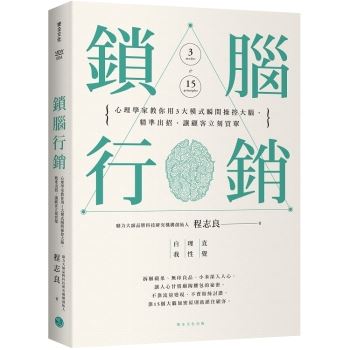機器學習作為人工智能最重要的技術和工具,已成功應用於解決各種複雜問題。
本書在簡略介紹機器學習的基本方法與算法的基礎上,通過搜集典型複雜問題的人工智能解決方案,諸如手寫數字識別、雷達自動目標識別、癌症診斷、超強噪聲污染情況下的圖像過濾、基因芯片異質性校正、孕婦子癇前期風險預測,以及一些典型的組合優化問題,如多約束最短路徑問題和旅行商問題等,考察如何運用機器學習技術,創造解決複雜問題的有效方法和算法,並通過這些案例窺視出人工智能技術的巨大優勢和其面臨的極其嚴峻的挑戰。
本書可作為本科生、研究生和博士生學習機器學習相關課程的教材,也可供高校計算機科學、人工智能、自動化等專業技術人員,以及對機器學習、人工智能感興趣的研究人員和工程師參考。
| FindBook |
|
有 1 項符合
張軍英的圖書 |
 |
$ 256 | 大數據中極端問題的人工智能解決方案(英文)
作者:張軍英 出版社:西安電子科技大學出版社 出版日期:2024-02-01 語言:簡體中文 規格:平裝 / 197頁 / 19 x 26 x 1 cm / 普通級/ 1-1  看圖書介紹 看圖書介紹
|
|
|
圖書介紹 - 資料來源:博客來 評分:
圖書名稱:大數據中極端問題的人工智能解決方案(英文)
內容簡介
目錄
CHAPTER 1 Basics of Machine Learning
1.1 Problem statement and solution framework
1.2 Supervised learning
1.2.1 MLP
1.2.2 CNN
1.2.3 RBF network
1.2.4 SVM
1.2.5 Comments
1.3 Unsupervised learning
1.3.1 K-means
1.3.2 Self-organizing map
1.3.3 Comments
1.4 Representation learning
1.4.1 PCA
1.4.2 LDA
1.4.3 ICA
1.4.4 NMF
1.4.5 Comments
References
CHAPTER 2 Solving Multi-class Problems by Data-driven Topology-preservingOutput Codes
2.1 Think: Is complexity important?
2.2 Topology-preserving output code scheme
2.2.1 A first-place description
2.2.2 Definition of a TPOC map
2.2.3 TOP map learned from SOM
2.2.4 Learning algorithm for a TPOC map
2.2.5 An octa-phase-shift-keying (8-PSK) pattern example
2.3 Experimental results
2.3.1 Comparison of TPOC with DECOC
2.3.2 Comparison of TPOC with OAA
2.3.3 Comparison of TPOC with random code and natural code
2.3.4 Comparison of TPOC with q-TPOC scheme and ECOC scheme
2.3.5 Comparison of TPOC schemes with and without adaptive assignment of classifier complexity
2.3.6 Measured radar data classification with multiple SVM
2.4 Discussions
2.4.1 Advantages of TPOC over ECOC
2.4.2 Relation of TPOC to other related approaches
2.5 Summary
Appendix Coding classes from a TPOC map
Appendix 1 k-ary coding scheme: Using k-ary classifiers
Appendix 2 Binary coding scheme: Using binary classifiers
References
CHAPTER 3 Robust Data Clustering by Learning Multi-metric Lq-norm Distances
3.1 Why distance measure is important?
3.2 Motivation for robust multi-metric clustering
3.3 Robust location estimation
3.3.1 RMML algorithm
3.3.2 Objective function
3.3.3 Non-Gaussianity measure of a mapped cluster
3.4 Robust outlier detection: ICSC algorithm
3.5 Experiments and results
3.5.1 Location estimation on alpha-stable mixture datasets
3.5.2 Comparisons of proposed RMML algorithm with typical robust clustering algorithms
3.5.3 Outlier detection on R-data and D-data
3.5.4 Experiments on Wisconsin Breast Cancer Dataset and on Lung Cancer Dataset
3.6 Discussions
3.7 Summary
Appendix 1 CDM algorithm
Appendix 2 Proof of Theorem 3.1
References
CHAPTER 4 Minimum Resource Neural Network Framework for SolvingMulti-constraint Shortest Path Problems
4.1 Introduction
4.2 MRNN for solving time constraint shortest time path problems
4.2.1 Problem definitions
4.2.2 Neural network design
4.2.3 Algorithm for solving the ST-TW problem
4.2.4 Flexibility of the network
4.2.5 Properties of the network
4.3 MRNN for solving label-constraint shortest path problem
4.4 Computation complexity analysis
4.5 Experiments and results
4.5.1 Experiments on simulated data
4.5.2 Experiments on real city road maps
4.5.3 Experiments on vehicle routing problem with time windows
4.6 Summary
Appendix Proof of properties of the TW-TW network
References
CHAPTER 5 Overall-Regional Competitive Self-Organizing Map for EuclideanTraveling Salesman Problem
5.1 Introduction
5.2 ORC-SOM neural network
5.2.1 Overall competition and regional competition: idea
5.2.2 Overall competition and regional competition: formation
5.2.3 ORC-SOM algorithm for the Euclidean TSP
5.3 Feasibility analysis
5.3.1 Neighborhood preservation and convex-hull properties
5.3.2 Infiltration property
5.4 Experiments and results
5.5 Summary
References
CHAPTER 6 Filtering Images Contaminated with Pep and Salt Type Noise with Pulse-coupled Neural Network
6.1 Introduction
6.2 PCNN model and its dynamic behaviour
6.2.1 Dynamics of an isolated neuron
6.2.2 Dynamics of connected neurons
6.3 Localization and filtering of noisy pixels
6.3.1 Basic idea
1.1 Problem statement and solution framework
1.2 Supervised learning
1.2.1 MLP
1.2.2 CNN
1.2.3 RBF network
1.2.4 SVM
1.2.5 Comments
1.3 Unsupervised learning
1.3.1 K-means
1.3.2 Self-organizing map
1.3.3 Comments
1.4 Representation learning
1.4.1 PCA
1.4.2 LDA
1.4.3 ICA
1.4.4 NMF
1.4.5 Comments
References
CHAPTER 2 Solving Multi-class Problems by Data-driven Topology-preservingOutput Codes
2.1 Think: Is complexity important?
2.2 Topology-preserving output code scheme
2.2.1 A first-place description
2.2.2 Definition of a TPOC map
2.2.3 TOP map learned from SOM
2.2.4 Learning algorithm for a TPOC map
2.2.5 An octa-phase-shift-keying (8-PSK) pattern example
2.3 Experimental results
2.3.1 Comparison of TPOC with DECOC
2.3.2 Comparison of TPOC with OAA
2.3.3 Comparison of TPOC with random code and natural code
2.3.4 Comparison of TPOC with q-TPOC scheme and ECOC scheme
2.3.5 Comparison of TPOC schemes with and without adaptive assignment of classifier complexity
2.3.6 Measured radar data classification with multiple SVM
2.4 Discussions
2.4.1 Advantages of TPOC over ECOC
2.4.2 Relation of TPOC to other related approaches
2.5 Summary
Appendix Coding classes from a TPOC map
Appendix 1 k-ary coding scheme: Using k-ary classifiers
Appendix 2 Binary coding scheme: Using binary classifiers
References
CHAPTER 3 Robust Data Clustering by Learning Multi-metric Lq-norm Distances
3.1 Why distance measure is important?
3.2 Motivation for robust multi-metric clustering
3.3 Robust location estimation
3.3.1 RMML algorithm
3.3.2 Objective function
3.3.3 Non-Gaussianity measure of a mapped cluster
3.4 Robust outlier detection: ICSC algorithm
3.5 Experiments and results
3.5.1 Location estimation on alpha-stable mixture datasets
3.5.2 Comparisons of proposed RMML algorithm with typical robust clustering algorithms
3.5.3 Outlier detection on R-data and D-data
3.5.4 Experiments on Wisconsin Breast Cancer Dataset and on Lung Cancer Dataset
3.6 Discussions
3.7 Summary
Appendix 1 CDM algorithm
Appendix 2 Proof of Theorem 3.1
References
CHAPTER 4 Minimum Resource Neural Network Framework for SolvingMulti-constraint Shortest Path Problems
4.1 Introduction
4.2 MRNN for solving time constraint shortest time path problems
4.2.1 Problem definitions
4.2.2 Neural network design
4.2.3 Algorithm for solving the ST-TW problem
4.2.4 Flexibility of the network
4.2.5 Properties of the network
4.3 MRNN for solving label-constraint shortest path problem
4.4 Computation complexity analysis
4.5 Experiments and results
4.5.1 Experiments on simulated data
4.5.2 Experiments on real city road maps
4.5.3 Experiments on vehicle routing problem with time windows
4.6 Summary
Appendix Proof of properties of the TW-TW network
References
CHAPTER 5 Overall-Regional Competitive Self-Organizing Map for EuclideanTraveling Salesman Problem
5.1 Introduction
5.2 ORC-SOM neural network
5.2.1 Overall competition and regional competition: idea
5.2.2 Overall competition and regional competition: formation
5.2.3 ORC-SOM algorithm for the Euclidean TSP
5.3 Feasibility analysis
5.3.1 Neighborhood preservation and convex-hull properties
5.3.2 Infiltration property
5.4 Experiments and results
5.5 Summary
References
CHAPTER 6 Filtering Images Contaminated with Pep and Salt Type Noise with Pulse-coupled Neural Network
6.1 Introduction
6.2 PCNN model and its dynamic behaviour
6.2.1 Dynamics of an isolated neuron
6.2.2 Dynamics of connected neurons
6.3 Localization and filtering of noisy pixels
6.3.1 Basic idea
|











